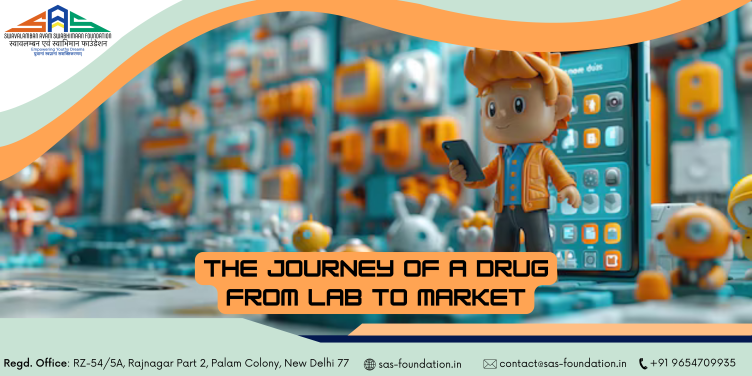From Lab to Life: Understanding the Journey of a Drug to Your Pharmacy Shelf
Have you ever picked up a medicine from your local pharmacy and wondered about the story behind it? That small tablet or capsule in your hand represents years of hard work, rigorous testing, and an incredible collaboration between science, regulation, and human dedication. The journey from a laboratory discovery to a life-saving drug available on pharmacy shelves is complex, fascinating, and vital to public health. This journey is at the heart of what is now called Pharma 4.0 — a new era in pharmaceutical innovation driven by digitalization, data, and intelligent systems.
Step 1: Drug Discovery and Early Research
It all begins in the lab. Researchers identify a disease or medical condition that needs better treatment options. They dive into understanding the disease mechanism, often exploring molecular biology, genetics, and bioinformatics. This step can involve screening thousands of potential compounds to find the one with the desired biological effect. These compounds are often synthesized in-house or sourced from natural products.
Modern drug discovery is increasingly aided by artificial intelligence and machine learning, which help predict how molecules might behave in the body. This phase can take several years and is extremely resource-intensive. For every 5,000 to 10,000 compounds screened, only a handful may move forward.
Step 2: Preclinical Testing
Before any human testing begins, promising compounds undergo preclinical studies. These studies assess the compound’s safety and efficacy in cell cultures and animal models. The goal is to understand how the drug behaves in a living organism: how it is absorbed, distributed, metabolized, and excreted (ADME), and whether it has toxic effects.
If a compound shows promise and no unacceptable toxicity, the company compiles all preclinical data into an Investigational New Drug (IND) application, which is submitted to regulatory agencies (such as the FDA in the U.S. or CDSCO in India) to seek permission to begin clinical trials.
Step 3: Clinical Trials
Clinical trials are conducted in three main phases, each with a distinct purpose:
- Phase I involves 20 to 100 healthy volunteers and focuses on determining the drug’s safety, dosage range, and side effects.
- Phase II involves a larger group (100 to 300 people) with the disease or condition. This phase assesses efficacy and further evaluates safety.
- Phase III is the most extensive and includes 1,000 to 3,000 patients. It confirms effectiveness, monitors side effects, and compares the drug to standard treatments.
Trials must adhere to Good Clinical Practice (GCP) guidelines, ensuring ethical standards and data integrity. Clinical trials can take 6 to 7 years, and only a small percentage of drugs pass all three phases.
Step 4: Regulatory Review and Approval
After successful clinical trials, the drug sponsor submits a New Drug Application (NDA) or a Biologics License Application (BLA) to the regulatory body. This submission includes comprehensive data from preclinical and clinical studies, proposed labeling, manufacturing processes, and quality controls.
Regulatory agencies thoroughly review the submission, often requiring further data or clarification. Independent advisory committees may also evaluate the findings. Approval means the agency is satisfied that the drug is effective for its intended use and that its benefits outweigh any risks.
In India, this process is overseen by the Central Drugs Standard Control Organization (CDSCO) under the Ministry of Health and Family Welfare.
Step 5: Manufacturing and Quality Assurance
Once approved, the drug enters full-scale production. Ensuring consistent quality is paramount. Manufacturing facilities must comply with Good Manufacturing Practices (GMP), which cover everything from hygiene standards to process validation.
Companies use automated systems, robotics, and digital analytics — key elements of Pharma 4.0 — to enhance efficiency and maintain product quality. Batch testing and quality assurance ensure that every pill or injection meets the same rigorous standards.
Step 6: Marketing and Post-Marketing Surveillance
After market approval, the drug is made available to healthcare providers and patients. But the journey doesn’t end here. Continuous post-marketing surveillance (also known as Phase IV) is vital to detect any rare or long-term side effects.
Pharmaceutical companies work closely with regulatory agencies to collect real-world data, report adverse events, and, if necessary, update safety guidelines or even withdraw a drug. This ensures ongoing public safety and reflects the dynamic nature of drug development.
Embracing Pharma 4.0
Pharma 4.0 represents the future of pharmaceutical development. Leveraging big data, IoT (Internet of Things), AI, and blockchain, this approach enables:
- Real-time monitoring of clinical trials
- Predictive maintenance of manufacturing equipment
- Enhanced patient engagement and compliance
- Greater transparency and traceability
By embracing these technologies, the industry is not only speeding up development timelines but also improving outcomes for patients worldwide.
Why It Matters
Understanding the drug development process enhances public trust and appreciation for science. It also underscores the importance of patient participation in clinical trials, regulatory oversight, and ethical conduct. Moreover, it opens up opportunities for students and professionals to contribute to this dynamic field, from pharmacology and biotechnology to regulatory affairs and health policy.
Final Thoughts
From lab benches to pharmacy shelves, every drug’s journey is a story of innovation, persistence, and collaboration. It’s a testament to human ingenuity and our collective effort to combat disease and enhance well-being. As technology evolves, so too does our ability to bring safer, more effective treatments to those in need.
So the next time you take a tablet, remember the remarkable journey behind it — a journey powered by science, guided by ethics, and driven by hope.
Stay informed with more insights like these by subscribing to our Pharma 4.0 newsletter. Together, let’s shape the future of healthcare!










